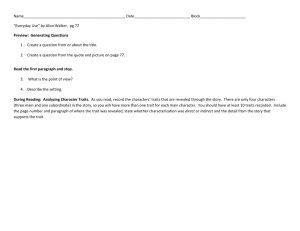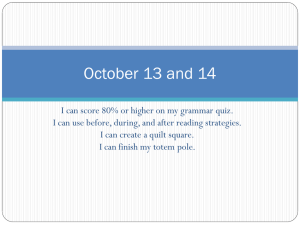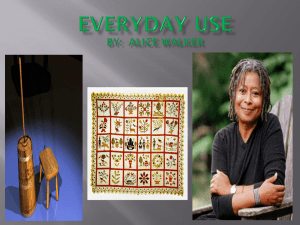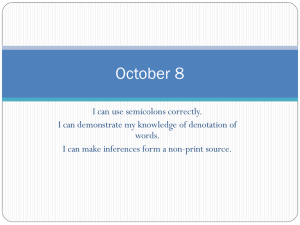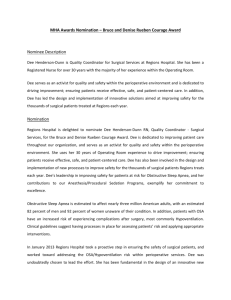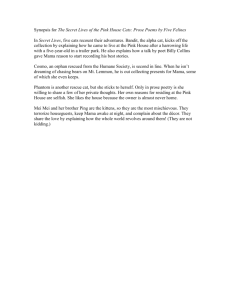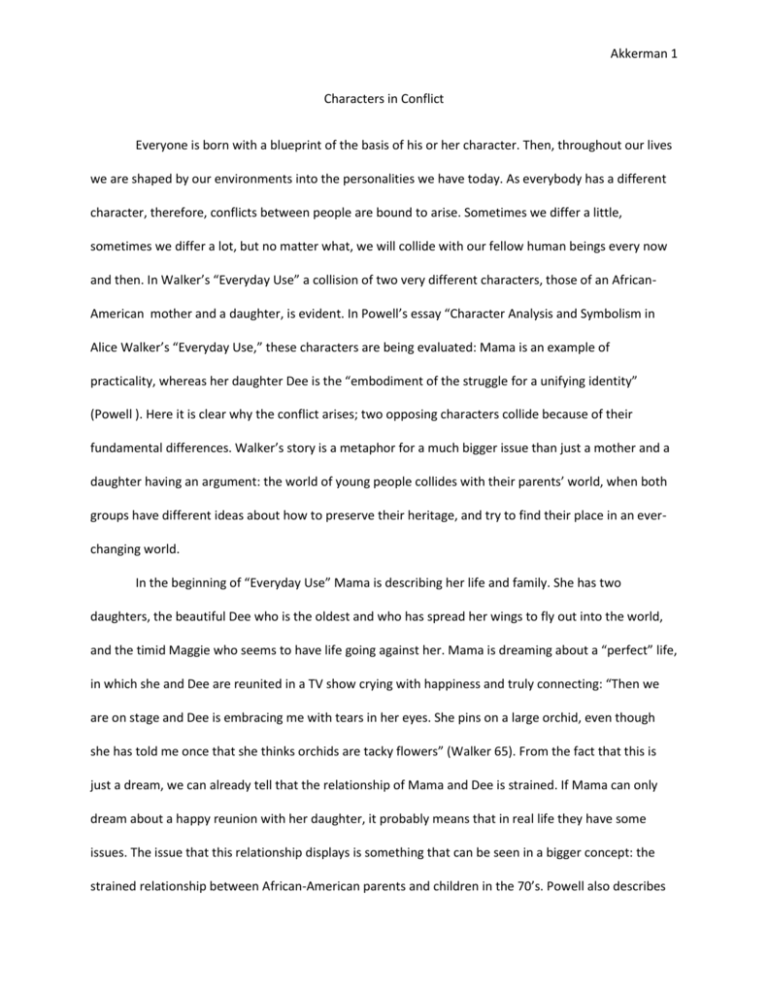
Akkerman 1
Characters in Conflict
Everyone is born with a blueprint of the basis of his or her character. Then, throughout our lives
we are shaped by our environments into the personalities we have today. As everybody has a different
character, therefore, conflicts between people are bound to arise. Sometimes we differ a little,
sometimes we differ a lot, but no matter what, we will collide with our fellow human beings every now
and then. In Walker’s “Everyday Use” a collision of two very different characters, those of an AfricanAmerican mother and a daughter, is evident. In Powell’s essay “Character Analysis and Symbolism in
Alice Walker’s “Everyday Use,” these characters are being evaluated: Mama is an example of
practicality, whereas her daughter Dee is the “embodiment of the struggle for a unifying identity”
(Powell ). Here it is clear why the conflict arises; two opposing characters collide because of their
fundamental differences. Walker’s story is a metaphor for a much bigger issue than just a mother and a
daughter having an argument: the world of young people collides with their parents’ world, when both
groups have different ideas about how to preserve their heritage, and try to find their place in an everchanging world.
In the beginning of “Everyday Use” Mama is describing her life and family. She has two
daughters, the beautiful Dee who is the oldest and who has spread her wings to fly out into the world,
and the timid Maggie who seems to have life going against her. Mama is dreaming about a “perfect” life,
in which she and Dee are reunited in a TV show crying with happiness and truly connecting: “Then we
are on stage and Dee is embracing me with tears in her eyes. She pins on a large orchid, even though
she has told me once that she thinks orchids are tacky flowers” (Walker 65). From the fact that this is
just a dream, we can already tell that the relationship of Mama and Dee is strained. If Mama can only
dream about a happy reunion with her daughter, it probably means that in real life they have some
issues. The issue that this relationship displays is something that can be seen in a bigger concept: the
strained relationship between African-American parents and children in the 70’s. Powell also describes
Akkerman 2
this in her essay, for she writes that Dee is a “selfish and egotistical character” and has “superficial
understanding of her inheritance that characterizes the confusion and misguidance of young African
Americans” during the Civil Rights and Black Power era (Powell ). During this time society was changing a
lot: while younger African American people want to be a part of the American culture, they also want to
show they still respect their African background. However, the way they tried to do this was not
respectful to their heritage according to their parents. This is a problem that often arises when the
second generation of an immigrant community grows up, and it is very current as the world is
globalizing ever more. While the first generation has had its own problems, trying to make a new life for
themselves far away from home, and trying to fit into a new society, the second generation is born and
raised in the new county feeling scattered between loyalty towards their parent’s culture and heritage,
and merging completely with the new culture they see at school and in their friends’ houses. Hence the
confusion that often seems to plague the second (and in some cases third) generations of immigrants,
and their misguidance about their heritage.
As “Everyday Use” continues, Mama and Maggie are visited by Dee and her partner. An
argument arises immediately after Mama finds out that Dee changed her name to Wangero. When Dee
says she took a traditional African name to honor her heritage, as the name “Dee” originated from the
White oppressor (according to Dee), Mama knows this is not true, and tries to argue with Dee about
this. After Dee asks who she is named after, and Mama says she is named after her aunt and
grandmother, Dee keeps asking who the consecutive family members are named after: “But who was
she named after?” asked Wangero. “I guess after Grandma Dee,” I said. And who was she named after?”
asked Wangero. “Her mother,” I said, and saw Wangero was getting tired. “That’s about as far back as I
can trace it,” I said. Though, in fact, I probably could have carried it back beyond the Civil War through
the branches” (Walker, 67). We see here that Mama gives up on Dee in the end, not wanting to cause a
longer argument, her character is changing, as she sees Dee just does not get it. In the beginning of the
Akkerman 3
story Mama still wanted a happy ending for them, but in the middle of the story we see a shift in her
mood towards seeing how different Dee and she are. Mama’s character is fundamentally different from
that of her daughters, especially than that of Dee: “Her practical nature and appreciation for heritage
distinguishes her from her two daughters, and represents the complex, historical importance of the
African-American culture.” (Powell) This could have a deeper meaning that can be tied back to the
theme of the story; as African American parents begin to see how different their children perceive
heritage, and have different ideas on how to preserve it, the gap is widening, and it doesn’t seem like
there is a lot the parents can do to become closer to their children without having too much conflict
about it. So in the end, they choose to forgive them their errant ways. In real life it also goes this way
sometimes. Some parents don’t want to fight with their children all the time, also understanding that
the times have changed, and that the kids simply have different ideas than they have, so they give up on
their kids when it comes to education about their backgrounds, and “set them free” reluctantly in order
to keep the relationship good. This can actually create distance parents and children, however, because
they live in such different worlds.
In the end of the story, something interesting happens between Mama and Dee. Dee wants to
take home some quilts which Mama already promised to Maggie. Normally Dee tends to get what she
wants, and Maggie doesn’t, but Mama is changing this for once: “I did something I never had done
before: hugged Maggie to me, then dragged her on into the room, snatched the quilts out of Miss
Wangero’s hands and dumped them into Maggie’s lap” (Walker 70). Mama is showing an interesting
change of character here, rooting for the daughter who seems to understand their heritage better than
Dee. Deep inside, Mama feels that Maggie has an inherent understanding of how to truly preserve their
heritage, and this shows in the way Mama responds when Dee, who would put the quilts on display in
her living room for all her friends to see, accuses her sister of “being backwards enough to put the quilts
to everyday use” (Walker 69). When Dee says that, Mama responds in favor of exactly that: “’I reckon
Akkerman 4
she would,’” I said. ‘God knows I been saving ‘em for long enough with nobody using ‘em. I hope she
will.’” (Walker 69) This shows a clear change in Mama’s feelings, who at first only wanted peace with
Dee. Now Mama seems to realize something she didn’t see, or didn’t want to see before: the difference
between her and Dee is just too big. They both have a very different understanding of their heritage,
and Dee will never see it the way Mama sees it. Mama is still in touch with their real heritage, while Dee
drifted away from it. This is essential to the point Walker is trying to make in “Everyday Use”: she wants
to challenge people to think about what their real heritage is, and what is only popular culture.
Nowadays, a whole new subculture has emerged, especially in arts like music and movies, which does
not have much to do with traditional culture anymore, but not everyone might understand that. When
Dee states that she would like to put the quilts on display for her friends and other visitors, she thinks
that she is respecting her heritage. But actually, by putting the quilts on display Dee is “conforming to
the worst of American ideals (…) disrespecting her own cultural heritage—all under the pretenses of
preserving it.” (Powell) Walker tries to tell us this by using the quilts as a symbol for heritage, the quilts
that are originally intended for daily use, and are put on display by the younger generation in so-called
respect of their heritage.
In the end we see a very different picture from what we saw in the beginning, when Mama was
dreaming of making peace with Dee. In the middle of the story it seemed that Mama was just getting
tired of arguing with Dee, knowing she wouldn’t understand anyway, but in the end Dee went too far.
Mama stood up for Maggie, and therefore stood up for their heritage. It is a conflict that has been
arising ever since people started to search for new lands, and the world became a global place: now the
world is becoming one giant melting pot in which every cultural group is trying to preserve its own
culture and heritage. This is a natural thing for groups of people, as having a common ground is the way
people bond and form groups. We are social beings who need to feel like we belong somewhere, and
being with a group where members have a similar background accommodates this need. But as we see
Akkerman 5
in “Everyday Use,” this does not happen without conflict in a society that is always changing. Conflicts
arise between generations when younger people seem to want other things in life than their parents,
and a mutual understanding and respect is necessary if we want to resolve this kind of
misunderstandings.
Akkerman 6
Works Cited
Powell, Rachel. “Character Analysis and Symbolism in Alice Walker’s ‘Everyday Use.’” Associated Content
3 Dec. 2007. Web. 9 April 2009. PRINT.
Walker, Alice. “Everyday Use.” Literature: An Introduction to Fiction, Poetry, Drama,and Writing. Ed. X.J.
Kennedy and Dana Gioia. 5th compact ed. New York: Pearson Longman, 2007. 64-70.

